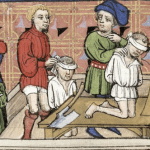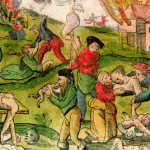 Animals
Animals  Animals
Animals  Facts
Facts Ten Unexpectedly Fascinating Facts About Rain
 Crime
Crime 10 Dark Details of Australia’s Gruesome Unsolved Wanda Murders
 Humans
Humans 10 Unsung Figures Behind Some of History’s Most Famous Journeys
 Animals
Animals 10 Species That Refused to Go Extinct
 Weird Stuff
Weird Stuff 10 Weird Things People Used to Do at New Year’s
 Our World
Our World 10 Archaeological Discoveries of 2025 That Refined History
 Weird Stuff
Weird Stuff 10 Fascinating Facts You Might Not Know About Snow
 Miscellaneous
Miscellaneous Top 10 Things Crypto Was Supposed to Change & What Actually Did
 History
History 10 Huge Historical Events That Happened on Christmas Eve
 Animals
Animals 10 Strange Times When Species Evolved Backward
 Facts
Facts Ten Unexpectedly Fascinating Facts About Rain
 Crime
Crime 10 Dark Details of Australia’s Gruesome Unsolved Wanda Murders
Who's Behind Listverse?

Jamie Frater
Head Editor
Jamie founded Listverse due to an insatiable desire to share fascinating, obscure, and bizarre facts. He has been a guest speaker on numerous national radio and television stations and is a five time published author.
More About Us Humans
Humans 10 Unsung Figures Behind Some of History’s Most Famous Journeys
 Animals
Animals 10 Species That Refused to Go Extinct
 Weird Stuff
Weird Stuff 10 Weird Things People Used to Do at New Year’s
 Our World
Our World 10 Archaeological Discoveries of 2025 That Refined History
 Weird Stuff
Weird Stuff 10 Fascinating Facts You Might Not Know About Snow
 Miscellaneous
Miscellaneous Top 10 Things Crypto Was Supposed to Change & What Actually Did
 History
History 10 Huge Historical Events That Happened on Christmas Eve
10 Scary Tales from the Middle Ages That’ll Keep You up at Night
There’s nothing quite like a good scary story. One that’ll really keep you up at night, tossing and turning as you think about the creepiness for hours. Right? But it’s not just modern-day stuff that makes for the perfect spooky tale. Centuries ago, they had some pretty darn good ghost stories, too. People in the Middle Ages were just as creepy and into spooky stories as we are now. And they backed it up with stunning tales of spirits and apparitions!
In this list, we’ll take a look at ten of the best scary stories from the Middle Ages that we’ve ever come across. These ten tales will certainly shock you. They might even keep you up at night and scared to see what the creaking noise is down the hall. You’d do well to log these in your mind and save them to tell other people, too. Best to spread the fear around than keep it all to yourself!
Related: Top Ten Ghosts and Cryptids Based on Witches
10 The Incestuous Ghost
There was a medieval knight named Henry Nodus who, during his life, was said to be remarkably wicked. Accusations of horrific things, including perjury, incest, adultery, and other similar vices, surrounded him for years. Then, after he died, word has it that he kept up his awful ways. People around the area in which he lived began to report that he had appeared to them as a ghost wearing “a sheep skin,” which was a reference to a condom. The incest accusations continued, too, with people claiming that his ghost was most often seen at the home of his daughter. Eww….
People tried to stop Nodus’s ghost from going on these visits by doing various things, including confronting him with the Christian cross and even trying to hit the ghost with a sword. None of it seemed to work, though. That is until the nearby bishop consulted with the locals and told them to sprinkle holy water at both Nodus’s house and the one where his surviving daughter lived. As the legend goes, after that was done, Nodus’s ghost never again showed up to torment people (or, uh, have interactions with his daughter) in the middle of the night. Creepy… and gross.[1]
9 Revenge from the Grave
Icelandic sagas are chock-full of crazy ghost stories and tales of the walking dead. There is one family saga in particular, known as the “Eyrbyggja saga,” about the people of a place known as Eyri, where several hauntings occur. In that saga, the story of a man named Arnkel and his father, Thorolf Half-foot, rises above all the rest when it comes to sheer creepiness.
As the story goes, Thorolf Half-foot died sitting up, with his eyes open, while seated at the family’s dining table. Based on superstition at the time, Arnkel warned the rest of his family not to walk in front of the dead man’s line of sight. He also covered the dead man’s face with a sheet. Then, Arnkel ordered a hole to be cut in the wall to remove the body. That part of the superstition was likely done to confuse Thorolf’s ghost; if it didn’t leave the house through the door, it wouldn’t then try to return through the door, either.
There was just one little problem: Thorolf’s ghost was resilient and relentless. Both of the oxen who carried Thorolf to his grave died soon after that. Other animals that went near the burial site died mysteriously immediately afterward, too. The spirit of Thorolf then began to haunt the valley in which he was buried. His hauntings were so scary that Arnkel eventually had the body moved to a new gravesite. The family even had a wall built around the grave to keep Thorolf from ravaging local villages and killing more livestock.
Sadly, soon after that, Arnkel himself was killed—supposedly in mysterious circumstances. Thorolf’s ghost then came back with a vengeance, wreaking havoc upon the region in a bid to seek revenge for his son’s death. This time, a second group of men exhumed Thorolf’s body and burned it. Then, they scattered the ashes into the sea.
But unfortunately for them, some of the ashes were caught in the wind and carried to land. There, a cow accidentally ingested them. She then gave birth to a bull who killed a man who had been one of Arnkel’s biggest enemies. And in that way, Thorolf Half-foot was said to have finally gotten his revenge.[2]
8 Fighting Off the Devil

At the height of the medieval era, in the small village of Berwick, England, a wealthy man passed away. His death shouldn’t have attracted much notice, but locals swore that he had been murdered by Satan himself. Then, after the man was buried, Satan reportedly made himself known by going after neighbors! And you can’t even imagine the terror it caused! Berwick natives began to stay inside at night because they were convinced they would be attacked if they ventured outside. Eventually, after nearly a full week paralyzed by complete fear of the supposed Satan in their midst, they took action.
Ten young men in the area who were renowned for their bravery volunteered to dig up the rich man’s body. They cut it limb from limb, then chopped it some more and threw it all into a big fire. That seemed to do the trick, and the Satan-related monster went away… for a while.
Not long after the body was burned and the whole town finally quieted down, they were visited by a plague. As the story goes, it was a direct consequence of the townspeople having fought off Satan’s advances in such a violent and aggressive way: “A pestilence, which arose in consequence, carried off the greater portion of them: for never did it so furiously rage elsewhere.”[3]
7 The Dead Baker

Near the very end of the medieval era, by the late 15th century, a story about a dead baker began circulating around Brittany, France. The issue was that the baker had supposedly come back to life again and again after dying. The rest of the village he lived in was said to have become exhausted by it. And in what wound up being his final resurrection after death, he was said to have gone back to his home to knead dough to make bread. Predictably, the rest of his family was terrified, and they all ran away. We would, too!
At that point, the undead baker apparently took a little bit of a heel turn. After villagers tried to forcibly get rid of him, he started throwing rocks at them from afar. He tore up the village, tried to ruin and burn down people’s homes, and committed other acts of mayhem. During that chaos, villagers saw that his legs were covered with mud up to his thighs. Confused, they went back to his gravesite and dug up his body—and it was muddied up in exactly the same way. Creepy!
But digging up the corpse also gave them an idea. They felt that if they could keep the body down in the grave and buried, the spirit of the baker wouldn’t terrorize them any longer. So, first, they tried to weigh his body down with rocks and other items in the grave. That failed to work, though. So, they opted to break both of the corpse’s legs. And what do you know? It worked perfectly! The ghost of the Brittany-based baker was never heard from again. To make an omelet, you’ve got to break some eggs, and to get rid of a baker, you’ve apparently got to break some bones.[4]
6 Crushed by a Ghost

One particularly creepy tale from the Middle Ages claims that a man died and was then interred, only to come back to life and haunt his wife. Specifically, he was keen on haunting her bedroom. She was asleep one night not long after his death, after having mourned his passing, when the ghost of her late husband supposedly “terrified her on awaking and nearly crushed her by the insupportable weight of his body.” Whoa! Seeing Casper the Friendly Ghost floating through the walls is one thing. But to have a ghost damn near crush you to death?! No, thank you!
The terror was far from over, though. The deceased man’s visits were so frequent and terrifying that the woman started bringing people into her bedroom to sit with her while she slept. She did so, hoping it would deter her ghost husband’s nightly visits. And it did, mostly—because he instead started terrorizing the entire town in her place. The deceased man started to become “a nuisance to his friends and neighbors” in much the same way as he had been to his wife as the story went.
Soon enough, the ghost then started showing up in the daylight hours, too. Townspeople immediately went to the local church to fix that problem. There, they begged the bishop to allow them to dig the man up and burn his body. The bishop turned down that request, though. Instead, he commanded that the townspeople open his tomb and leave the body alone. When they did, the bishop arrived and placed a “letter of absolution” on the man’s chest. And that cured it! The ghost supposedly never returned.[5]
5 The Ghost in the Doorway
Another Icelandic saga, known as the “Laxdæla saga,” about the group of people who lived in a place called Laxardal, was also terrifying. Written in the 13th century, it tells the story of a man named Hrapp. Sadly, Hrapp was extremely violent. And on his deathbed, he had a strange request: He wanted to be buried vertically in the doorway of his home so that he could keep an eye on his family from the afterlife. His survivors did just that, and sure enough, Hrapp saw to it that he haunted his family from the next world. He was said to have killed most of the family’s servants in various encounters. Things got so bad that his family and their staffers even completely abandoned the farm to try to avoid his wrath. Eventually, they relocated his body, too—but he still wouldn’t leave them alone.
In due time, a man named Olaf took over the property. But sadly, just days after he moved in, one of his servants came up to him petrified. The servant told Olaf that Hrapp wouldn’t leave the threshold of his now-former home. The ghost had even taken to wrestling with the servant who was trying to push him out. Olaf confronted Hrapp with a spear, but the spearhead was broken off, and Hrapp vanished.
The next day, Olaf took a group of brave men to Hrapp’s grave. There, they found his body hadn’t decayed in the slightest—and Olaf’s spearhead was buried with it. Terrified, Olaf ordered Hrapp to be dug up. They burned his body, cast off his ashes into the sea, and never had a moment of trouble from the ghost ever again.[6]
4 The Reattached Head

In the ninth century, when the Vikings were fully committed to their invasion and onslaught in England, a knight there named Edmund decided to turn himself over to the raiders instead of being killed and having his people overrun. According to writer Ælfric of Eynsham, who lived more than a century later and recounted those past events, Edmund tried to religiously convert the Vikings after he was captured.
However, they didn’t care for that behavior, so they tortured the knight. Then, they beheaded him and tossed his head into a forest. That was a problem for Christians because burial customs dictated that the deceased person’s entire body must be buried all together in anticipation of the resurrection of the dead at the Last Judgment.
Fortunately, a witness to the beheading knew exactly where the Vikings had thrown Edmund’s head. So a search party went into the woods and found the head. Miraculously, Edmund’s disembodied head was speaking to them, yelling, “Here, here, here!” It was also being guarded by a wolf, which had kept other animals at bay from eating it. After the head was recovered, Edmund’s body was reunited and given a martyr’s burial.
But here’s where things get really creepy: according to Ælfric, years after Edmund’s burial, his body was exhumed from the church graveyard to be given nicer digs. When it was exhumed, Ælfric claims that the diggers discovered Edmund’s head had reattached itself onto his body. There was only a thin red line around his neck—a scar from the beheading—but other than that, it was totally normal. Spooky![7]
3 The Persistent Ghost
That was far from the only spooky story Ælfric recounted in his time. He also wrote a tale of a saint named Swithun, whose gravesite years after his death had been mostly forgotten by his local community. Evidently mad at that, the ghost of Swithun appeared in a vision to a local blacksmith. The ghost told the blacksmith of an iron ring on top of the since-grown-over burial mound. He said the living man would be able to open it easily for a re-burial. But the blacksmith was terrified of the ghost and refused to do it. The ghost of Swithun tried three times before the blacksmith finally agreed to go to the grave.
Eventually, the blacksmith finds that Swithun’s ghost had indeed been telling the truth about the iron ring and the opening of the grave. But there was another problem: There was in-fighting going on at the church where Swithun had been buried, and local religious leaders refused to let the body be moved inside. So Swithun’s spirit took another route to get what he wanted. He began appearing in visions to other members of the community. In those visions, he told them that diseased people could visit his tomb, and they would miraculously be healed.
People started doing this and getting healed, according to Ælfric’s writings. It worked so well that the king took notice of the phenomenon. He ordered the local bishops to stop fighting at once. Then, he ordered them to re-inter Swithun’s body inside the church. The bishops finally agreed to do that, at which point even more people came to the church for healing. As Ælfric noted, the church soon saw dozens and dozens of miracles, with the late great saint Swithun healing all sorts of physical ailments. Good thing that ghost was so persistent![8]
2 Drunk for All Eternity

Rudinger was a medieval knight who lived in Cologne, Germany. Unfortunately for him, he was a full-blown alcoholic. He wasn’t able to escape his vices for alcohol during his lifetime, either, as the drink eventually killed him. But on his deathbed, he made a promise to his daughter: he would return and visit her from the spirit world exactly 30 days after he passed away. The daughter was skeptical but went along with it out of love for her father. But then, sure enough, as the story went, he really did come back exactly a month after he’d died.
During his reappearance, Rudinger’s daughter could see that the late knight had a mug in his hand. That was par for the course from when he was alive, so she wondered whether he was again somehow drinking alcohol from beyond the grave. After she asked him about it, the ghost of Rudinger informed her that it was an afterlife brew made up of sulfur and brimstone. And his penance in the afterlife was to drink it up—but to never be able to drain it completely.
Her father then disappeared again, forever gone off into the spirit world. After he departed, his daughter came to the horrifying realization: “There was little hope of his being saved. For in this life, wine is sweet to sip, but eventually, it carries the poison of a viper.” Honestly, that’s a very creepy anti-drinking PSA. Maybe we should put THAT in schools.[9]
1 The Terrifying Best Friend

Aswid was the son of a medieval ruler of the Scandinavian province of Wik. When he died an untimely death far too young, he was buried as he’d previously ordered, with his horse, his dog, and his best friend. The friend, Asmund, was still alive and perfectly healthy at the time of Aswid’s death. But the two of them had made a pact in which they’d offered an oath to each other to go into the afterlife together. Talk about a deep friendship! We don’t care how good of friends we are with someone; we’d definitely not die for them in that way. But that’s exactly what Asmund did—paying the ultimate price to be with his friend Aswid in the next life.
Long after that, a group of Swedes who were trekking through the backcountry happened upon the cave in modern-day Norway, where Asmund had spent his final living days with his best friend’s body. They sent a man inside to look for treasure. There, instead of finding any treasure, he saw Asmund’s “bloody face” with “blood flowing worth and spurting over it,” according to a Viking saga. It seemed as though Asmund, who had died of his own hand in honor of his fallen friend, had come back to life.
The saga tells what happened next: “Aswid had come to life in the nights… and in his continual struggles had wrenched off his left ear. The listless night of the cavern, the darkness of the ancient den, have taken all joy from my eyes and soul… ‘I have fought with the dead, enduring the heavy burden and grievous peril of the wrestle.’ Aswid rose again and fell on me with rending nails, by hellish might renewing ghastly warfare after he was ashes.”
Basically, Aswid went crazy after death and tried to devour the dog, then the horse, and then his very own best friend. Asmund’s only recourse to protect himself from the creepy afterlife cannibalism was to cut off Aswid’s head. He then impaled his (now former, we guess?) ghost best friend’s body on a stake to end the suffering. Imagine walking into a cave looking for treasure, and you find all THAT deep down in the dark! Creepy…[10]








